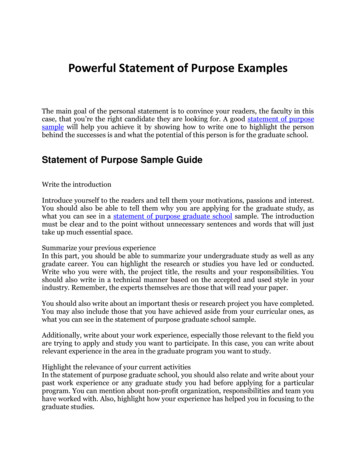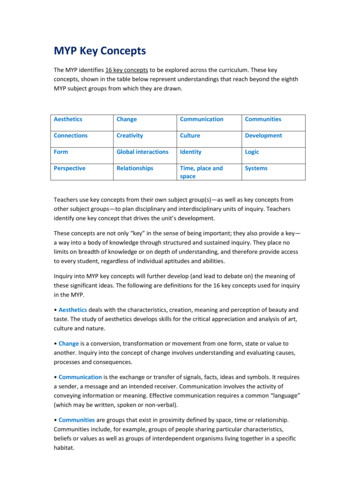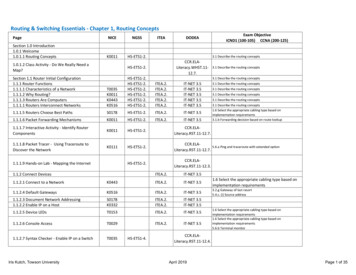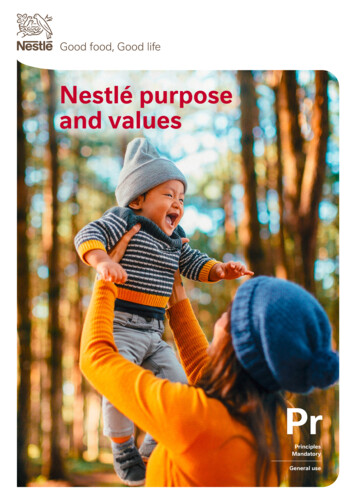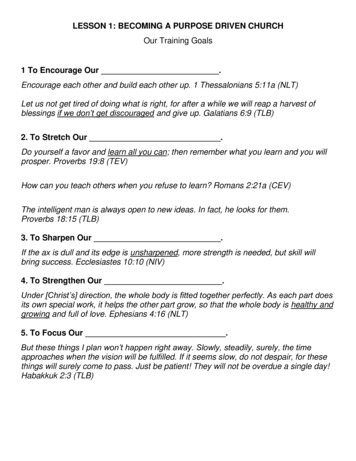
Transcription
22.Concepts and purpose ofKAP surveys2.1TerminologyInformation on KAP is captured using questions and is stated in terms of indicators. Tounderstand KAP surveys, you must be familiar with the following terminology. Indicator: Specific aspects of KAP to be measured. In this manual, indicators are mainlystated in terms of numbers, percentages or scores and are used to describe generaltrends concerning the KAP of a population or to measure changes that occur after anintervention. Question: Instrument to collect information about an indicator. Outcome: Specific measurable result of an intervention. This refers to changes in KAPidentified by comparing values of indicators from before and after the intervention wasintroduced. Participant population: Population that will participate in the intervention. Survey population: Population that will participate in the KAP surveys. Depending onthe circumstances, the survey population can be the entire participant population or asample of it. Respondent: An individual from the survey population who responds to the KAP surveyquestionnaire (also referred to as an informant). Surveyor/interviewer/enumerator: A trained individual who conducts interviews withrespondents of the survey population and fills out the KAP survey questionnaire. Survey manager/supervisor: An individual responsible of preparing, managing andconducting KAP surveys. He/she forms teams or groups, develops schedules for theteams and provides itineraries for them, including roadmaps, names of villages, phonenumbers and other information that might be useful. He/she is also responsible forchecking that questionnaires are filled out correctly and annotations are legible, foranalysing the collected data and writing the final report. Survey team: Survey managers and surveyors who work together on the same survey. Planner: A project planner who analyses the nutrition situation with a view to planning aproject or intervention. Evaluator: A project manager or external evaluator who evaluates the outcomes ofnutrition interventions/projects.4Guidelines for assessing nutrition-related knowledge, attitudes and practices - KAP Manual
2.2 PurposeKAP studies emerged in the 1950s from the need to measure opposition to family planningservices (14). Since then, they have been used extensively in family planning and populationstudies to evaluate and guide existing programmes, and their use has extended to otherareas of health, including nutrition.Nutrition-related KAP studies assess and explore peoples’ KAP relating to nutrition, diet,foods and closely related hygiene and health issues. KAP studies have been used for twomain purposes: (1) to collect key information during a situation analysis, which can thenfeed into the design of nutrition interventions and (2) to evaluate nutrition educationinterventions (Figure 1).Figure 1:Situation analysis and outcome evaluationSituation analysisAssessment of thelocal situation with aview to plan a projector interventionOutcome evaluationProject implementation/nutrition interventionCollection ofbaseline indicatorsComparison ofbaseline and endlineindicators to assess theintervention effectsCollection ofendline indicatorsSituation analysis for intervention planningIn the context of nutrition-related projects or programmes, a situation analysis describesthe type and magnitude of nutrition issues and identifies possible causes of the nutritionalproblems observed. The findings of a situation analysis will help in planning a nutritionintervention aimed at alleviating the nutrition problems identified.KAP studies can contribute to a situation analysis by helping determine the existingknowledge, attitudes and practices relating to nutrition, which identifies nutrition educationpriorities. The steps involved are as follows (1–18): “What we’ve got”:»» Identify local nutrition problems through secondary sources (e.g. national healthstatistics). Prioritize the nutrition issues that are most amenable to educationalmeans.»» Identify people’s dietary practices that are underlying the nutrition problems.»» Identify intrapersonal determinants of these practices, such as nutrition-relatedknowledge and attitudes.CHAPTER 2 – Concepts and purpose of KAP surveys5
“What we need”:»» Identify gaps in people’s knowledge, attitudes and dietary practices.»» Identify priority needs in nutrition education with a view to informing project orintervention design.Note: A situation analysis is different from a baseline survey. A situation analysis hasa planning function and is conducted during the project planning phase, whereas abaseline survey is part of monitoring and evaluation of the project or intervention andis conducted at the beginning of the implementation phase.Outcome evaluationMonitoring and evaluation are an essential part of project or intervention implementationand management, helping ensure that the project or intervention is on track and achievingits intended outcomes. They also allow project managers to demonstrate to fundingagencies, participants and local stakeholders that project funds were well spent and thatgoals were achieved.An outcome evaluation is an assessment conducted at the end of a project and providesinformation about the outcomes of the intervention (15, 19). It also demonstrates theintervention’s effectiveness by comparing levels of indicators before and after the project orintervention was implemented.Evaluations of nutrition interventions often focus on the long-term effects or impacts ofthe interventions. These are expressed in terms of biochemical and clinical indicators ofnutritional status (for example, haemoglobin levels) and indicators of growth in children,including wasting (being too thin for one’s height), stunting (being too short for one’s age)and underweight (being too thin for one’s age). These long-term indicators do not detectintermediate outcomes and must therefore be supplemented by indicators of short- andmedium-term outcomes. Short-term outcomes are immediate results of an intervention,such as changes in knowledge and prevailing attitudes (15, 20). Medium-term outcomes areapparent only after a more extended period and commonly result in changes in behaviour (i.e.practices).In contrast to indicators of physiological and health outcomes, these are social, psychologicaland behavioural outcomes, and are thus particularly relevant to monitoring the impact ofnutrition education (19, 21) (Table 1).Note: Assessing nutrition-related knowledge, attitudes and practices offers anopportunity to better understand a given situation by providing insights into thesocial, psychological and behavioral determinants of nutritional status.6Guidelines for assessing nutrition-related knowledge, attitudes and practices - KAP Manual
Table 1:Examples of short-, medium- and long-term outcomes of nutrition interventions thatinclude an educational componentShort-term outcomesLong-term outcomes(impact)Medium-term outcomesPhysiological and healthoutcomes*Social, psychological and behavioural outcomesChanges in intrapersonaldeterminants of practicesChanges in nutrition-related Changes in physiologicalpracticesparametersKnowledge and attitudes,among othersKnowledge Increased understandingof the benefits ofbreastfeeding Increased knowledgeof reasons for feedingyoung children with thickporridge rather thanwatery porridge Increased awareness of theconsequences of shortterm hunger at school Increased knowledgeof ways to prevent foodpoisoningNutritional status andbiochemical indicators Increased haemoglobin Increased intake of ironlevels among womenrich foods among pregnantwomen Decreased stunting ratesin children Increased meal frequencyamong young children Decreased underweightrates among infants Increased dietary diversity Decreased consumption of Increased weight gainamong pregnant womensoft drinks Greater use of iodized salt(Note: In food security projectsor programmes, impacts referto changes in household foodinsecurity, household hunger,household expenditure, wealthindex and similar measures)Attitudes Increased confidence inbeing able to prepare andenriched porridge(self-efficacy/confidence) Increased belief in benefitsof dietary diversity(perceived benefits) Increased preference fortargeted foods(food preference) Greater readiness to washone’s hands before eating(readiness to change)* The long-term outcomes (i.e. impact or physiological and health outcomes) should only be evaluatedseveral months or even years after the completion of the programme because long-term effects take timeto manifest.CHAPTER 2 – Concepts and purpose of KAP surveys7
Note: The boundary between short- and medium-term outcomes is less distinctthan that between medium-term and long-term outcomes. For example, someaspects of the dietary behaviour can change immediately after a nutrition educationintervention.2.3 Key indicators: knowledge, attitudes and practicesKnowledgeDefinition of knowledgeKnowledge is the understanding of any given topic (8). In this manual, it refers to anindividual’s understanding of nutrition, including the intellectual ability to remember andrecall food- and nutrition-related terminology, specific pieces of information and facts.Measurement of knowledgePartially categorized questionsPartially categorized questions are open-ended questions that require respondents toprovide short answers in their own words, accompanied by a list of correct answers plusthe options “Other” and “Don’t know.” Predefined options make analysis easier by listingexpected responses. After the surveyor has asked the question, he/she should write downthe response provided and then categorize it according to the predefined response options.Note: The respondent may not give the response exactly as it is written in thequestionnaire. It is up to the surveyor to understand the meaning of the responsesgiven and tick the closest answer in the list.Knowledge questions can have a single answer or several answers.Example of question with a single answerAt what age should babies start eating foods in addition to breastmilk? At six months Other Don’t knowPreliminary analysisKnowsDoes not know8Guidelines for assessing nutrition-related knowledge, attitudes and practices - KAP Manual
Example of question with several possible answersThere are key moments when you need to wash your hands to prevent germs fromreaching food.What are these key moments? After going to the toilet/latrine After cleaning a baby’s bottom/changing a baby’s nappy Before preparing/handling food Before feeding a child/eating After handling raw food After handling garbage Other Don’t knowPreliminary analysisKnowsDoes not knowNumber of correct responsesPreliminary analysisA box is provided to allow the surveyor to make a preliminary analysis of the responses toknowledge questions. If the question has a single correct answer, the options are “Knows”or “Does not know.” If the question has several correct answers, the options are “Knows”(if the respondent gives one, some or all possible correct answers), “Does not know” (if therespondent gives no correct answers) and “Number of correct responses” (to indicate thenumber of correct answers provided).The surveyor can make the preliminary analysis during the interview if he/she has therequisite analytical skills. If, however, the surveyor is unable to perform this analysis, thesupervisor should do it based on the surveyor’s notes, cross-checking with the surveyor ifnecessary.Other types of questionsKnowledge can also be measured through multiple choice questions and true/falsequestions. We do not recommend these types of questions because the responses can bethe result of guessing and therefore give a false impression of knowledge.CHAPTER 2 – Concepts and purpose of KAP surveys9
Indicators used to quantify knowledgeIndicators of knowledge can be reported in terms of numbers, percentages or scores.NumberExamples of numerical indicators include: number of respondents who know the correct answer to a question; number of respondents who do not know the correct answer to a question; number of respondents who know all of the correct answers to a question; and number of respondents who know three correct answers to a question, two correctanswers and so on.PercentagePercentages used as indicators of knowledge are determined from the numerical indicators.For example: percentage of respondents who know the correct answer to a question; percentage of respondents who do not know the correct answer to a question; percentage of respondents who know all of the correct answers to a question; and percentage of respondents who know three correct answers to a question, two correctanswers and so on.ScoreFor a score-based indicator of knowledge, each respondent is given a score based on thenumber of correct responses provided. The knowledge score of the population is calculatedfor each question by dividing the total number of correct responses by the number ofrespondents who answered the particular question. Exclude respondents who did notanswer the question, or for whom information is incomplete.Sum of correct responses given by all respondentsScore of knowledge per question Total number of respondentsAttitudesDefinition of attitudesAttitudes are emotional, motivational, perceptive and cognitive beliefs that positivelyor negatively influence the behaviour or practice of an individual (16, 22). An individual’sfeeding or eating behaviour is influenced by his/her emotions, motivations, perceptions andthoughts (23). Attitudes influence future behaviour no matter the individual’s knowledgeand help explain why an individual adopts one practice and not other alternatives (10). Theterms attitude, beliefs and perceptions are interchangeable.10Guidelines for assessing nutrition-related knowledge, attitudes and practices - KAP Manual
Measurement of attitudesAttitudes are measured by asking the respondents to judge whether they are positively ornegatively inclined towards: a health or nutrition problem; an ideal or desired nutrition-related practice; following nutrition recommendations or food-based dietary guidelines; food preferences; or food taboos.The respondent is asked to rate his/her answer on a three- or five-point scale (see “Box 1:Attitudes – three or five-point scale?”), called a Likert scale (8, 14–16, 23, 24). This methodis used for grading the intensity of respondents’ attitudes. This can be done orally or witha visual support (see Appendix 1, page 69) so as to help respondents with little education.We recommend the use of attitude questions offering three response options: one positive; a “middle option” that captures attitudes that are still uncertain; and one negative.Open-ended questions can be added in order to gain understanding of why respondentsgave a specific answer; these are optional and are only relevant to a situation analysis.Questions in the modules that are aimed at measuring attitudes were developed based on theHealth Belief Model.1 According to this model, people’s beliefs influence their health-relatedactions (15, 25, 26). It states that the likelihood that an individual will take action to preventa health problem depends on the individual’s perception of the condition’s severity and his/her likelihood of getting it, on the benefits of and barriers to taking action to reduce the riskof getting the condition and on his/her confidence in taking action. Additional variablesrelated to food consumption and food taboos were also included as attitudes. The definitionsof the attitude indicators are presented below and their measurement is illustrated in theform of scaled questions.Attitudes towards a health or nutrition problemWhen measuring both perceived susceptibility and severity, you should specify: the health or nutrition problem of interest; and the population related to this problem.1A health behaviour model is commonly used in health programmes to understand and explain humanbehaviour and factors that influence it, as well as to promote behaviour change. It can also be used asa basis for developing questions for measuring dietary knowledge and attitudes (25). The Health Belief Model was selected as its variables are easily measurable through survey questions; other modelsuse variables that require the use of qualitative methods.CHAPTER 2 – Concepts and purpose of KAP surveys11
Perceived susceptibilityPerceived susceptibility refers to an individual’s beliefs regarding his/her own or other’svulnerability to a health or nutrition problem.Example: Measuring the perceived susceptibility to iron deficiency/anaemiaHow likely do you think you are to be iron-deficient/anaemic? 1. Not likely 2. You’re not sure 3. LikelyIf Not likely:Can you tell me the reason why it is not likely?Perceived severityPerceived severity refers to an individual’s beliefs regarding the severity of a health ornutrition problem.Example: Measuring the perceived severity of signs of severe malnutritionHow serious do you think undernutrition is for a baby’s health? 1. Not serious 2. You’re not sure 3. SeriousIf Not serious:Can you tell me the reason why it is not serious?Box 1Attitudes – three or five-point scale?The modules in this manual use a three-point scale because pre-testing showedit was easier to measure attitudes with a three-point scale than with a five-pointscale. Respondents with little education felt confused by the five-point scale, i.e. byhaving to select among five different options. If you are dealing with better educatedparticipants, you could modify the questions to use the five-point scale, but you wouldthen need to pre-test the questions before using them in a survey.12Guidelines for assessing nutrition-related knowledge, attitudes and practices - KAP Manual
Attitudes towards an ideal nutrition-related practicePerceived benefitsPerceived benefits refer to an individual’s beliefs regarding the benefits he/she or someoneelse would gain from a practice.Example: Measuring perceived benefits of giving different types of food to a child each dayHow good do you think it is to give different types of food to your child each day? 1. Not good 2. You’re not sure 3. GoodIf Not good:Can you tell me the reasons why it is not good?Perceived barriersPerceived barriers reflect an individual’s beliefs regarding the difficulties arising fromengaging in a practice.Example: Measuring perceived barriers to breastfeedingHow difficult is it for you to breastfeed your baby exclusively for six months? 1. Not difficult 2. So-so 3. DifficultIf Difficult:Can you tell me the reasons why it is difficult?Self-confidenceSelf-confidence refers to an individual’s beliefs regarding his or her own ability to perform apractice or his or her confidence in doing so.CHAPTER 2 – Concepts and purpose of KAP surveys13
Example: Measuring a mother’s self-confidence in preparing enriched porridge for her childHow confident do you feel in preparing food for your child? 1. Not confident 2. Ok/so-so 3. ConfidentIf Not confident:Can you tell me the reasons why you do not feel confident?Readiness to change (optional)You can assess a respondent’s readiness to adopt a new or ideal nutrition-related practiceusing the Transtheoretical Model of Behaviour Change (15, 26, 27). This evaluates changesin self-reported behaviour (practice) and progress towards achieving the ideal behaviour.Appendix 2 (page 70) provides further information on how to measure readiness to changein nutrition-related KAP studies.Attitudes towards following nutrition recommendations or food-based dietaryguidelinesPerceived importance of following a nutrition recommendationThis addresses beliefs concerning the importance of following a nutrition recommendation,advice or message delivered through nutrition education or included in food-based dietaryguidelines (FBDG) (28). This indicator can help establish a link between FBDG and changesin dietary behaviour.Example: Measuring attitude towards the Guatemala Food GuideHow important is it to follow the Guatemala Food Guide? 1. Not important 2. You’re not sure 3. ImportantIf Not important:Can you tell me the reasons why it is not important?14Guidelines for assessing nutrition-related knowledge, attitudes and practices - KAP Manual
Figure 2: Guatemala Food Guidesugars and fatsat least once a weekmeat, fishat least once a weekdairy productsevery dayherbs,vegetablesfruitsevery daypulses,cereals,and potatoesIn order to stay healthy, wash your hands,and cover your food and drinking waterSource: 29.How important is it to follow the recommendation to consume dairy products at leasttwice a week? 1. Not important 2. You’re not sure 3. ImportantIf Not important:Can you tell me the reasons why it is not important?Attitudes towards food preferencesFood preferences should be assessed if one of the aims of the survey is to assess theacceptability of a specific food or meal. Food preferences are defined as sensory-affectiveresponses to a food or flavour that influence food choice and dietary practices (15). Foodpreferences are often assessed to determine if food items would be accepted beforepromoting them or to assess changes in preference or enjoyment of foods promoted duringan intervention.Example: Measuring liking for the flavour of soybeansHow much do you like the flavour of soybeans? 1. Dislike 2. Not sure 3. LikeCHAPTER 2 – Concepts and purpose of KAP surveys15
Attitudes towards food taboosFood taboos are dietary rules in a given culture, society or community that prescribe orproscribe certain food items or uses (30, 31). Food taboos are often associated with specialevents or phases of the human life cycle, such as illness, menstruation, pregnancy, childbirth,lactation, weddings, funerals, battles, etc. Many taboos concern the consumption ofanimal-source foods, often by those groups of the community most in need of protein (32).For example, in the Mid-Western Region of Nigeria, meat and eggs are not usually given tochildren because parents believe it will make the children steal (33). Liver is also commonlytaboo for children because it is believed to cause abscesses in their lungs.Food taboos can be assessed by evaluating the level of agreement with them. This assumesthat survey managers have at least some idea of what taboos already exist in the population.Researchers can obtain information about local food taboos from previous studies of foodtaboos in the region or country. If no such studies are available, the project will have toidentify food taboos before conducting the KAP survey; it can do this by using qualitativemethods with a small group of the participant population (for example, during the situationanalysis). Appendix 8 (page 178) provides basic information about methods for collectingand analysing qualitative data.Only food taboos that could negatively affect nutritional status need be assessed, as theseare the only ones that need to be modified.Example: Assessing a food taboo against lactating women consuming beansSome people believe that it is not good for a lactating woman to eat beans because itmight cause her to produce low-quality breastmilk that could be harmful to the baby.Do you disagree with this belief, you’re not sure or do you agree? 1. Disagree 2. Not sure/neutral 3. AgreeIndicators used to quantify attitudesIndicators used to quantify attitudes can be reported in terms of numbers, percentages orscores.NumberExamples of numerical indicators of attitudes include: number of respondents who think that their child is likely to become underweight(perceived susceptibility); number of respondents who think that their child is not likely to become underweight(perceived susceptibility); number of respondents who believe that oedema of both feet is a serious problem for ababy’s health (perceived severity);16Guidelines for assessing nutrition-related knowledge, attitudes and practices - KAP Manual
number of respondents who are not sure that adding fish to a baby’s meal is good(perceived benefits); number of respondents who think that breastfeeding their child is difficult or somewhatdifficult (perceived barriers); and number of respondents who feel confident in preparing an enriched porridge for theirchild (perceived self-efficacy).PercentagePercentages used as indicators of attitudes are determined from the numerical indicators.For example: percentage of respondents who think that their child is likely to become underweight(perceived susceptibility); percentage of respondents who think that their child is not likely to become underweight(perceived susceptibility); percentage of respondents who believe that oedema of both feet is a serious problem fora baby’s health (perceived severity); percentage of respondents who are not sure that adding fish to a baby’s meal is good(perceived benefits); percentage of respondents who think that breastfeeding their child is difficult orsomewhat difficult (perceived barriers); and percentage of respondents who feel confident in preparing an enriched porridge for theirchild (perceived self-efficacy).ScoreFor a score-based indicator of attitude, a numerical value or score is assigned to each choicein the range of responses. For example, if a question uses a five-point scale, a score of 1might be given to “strongly disagree”, 2 to “disagree”, 3 to “don’t know”, 4 to “agree” and5 to “strongly agree”. The attitude score of the population is calculated for each questionby dividing the total score for all participants who answered the question by the numberof respondents who answered the question. Exclude respondents who did not answer thequestion, or for whom information is incomplete.Sum of the scores of all respondentsScore of attitude per question Total number of respondentsCHAPTER 2 – Concepts and purpose of KAP surveys17
Table 2:Health and nutrition-related attitudesAttitudes towards a health or nutrition problemPerceived susceptibilityBeliefs regarding own or other’s vulnerability to a health ornutrition problemPerceived severityBeliefs regarding the severity of a health or nutrition problemAttitudes towards an ideal nutrition-related practicePerceived benefitsBeliefs regarding the benefits an individual would gain from apracticePerceived barriersBeliefs regarding the difficulties arising from engaging in apracticeSelf-confidenceBeliefs regarding own ability to perform a practice orconfidence in doing soReadiness to changeReadiness to adopt a new or ideal nutrition-related practiceAttitudes towards following nutrition recommendations or food-based dietary guidelinesPerceived importanceof following a nutritionrecommendationBeliefs concerning the importance of following a nutritionrecommendation, advice or message delivered throughnutrition education or included in a food-based dietaryguidelineOther attitudesFood preferencesSensory-affective responses to a food or flavour thatinfluence food choice and dietary practicesAttitudes towards foodtaboosLevel of agreement with a food taboo that could negativelyaffect nutritional statusPracticesDefinition of practicesIn this manual, the term “practices” is defined as the observable actions of an individual thatcould affect his/her or others’ nutrition, such as eating, feeding, washing hands, cookingand selecting foods.Practice and behaviour are interchangeable terms, although practice has a connotation oflong-standing or commonly practiced behaviour (15).18Guidelines for assessing nutrition-related knowledge, attitudes and practices - KAP Manual
Measurement of practices and indicators used to quantify themThis manual presents methods to assess nutrition-related practices in terms of: dietary diversity (quality of the whole diet) intake of specific foods frequency of intake of specific foods and specific observable behaviours.Table 3 (page 25) summarizes the different measurements used to quantify practices and theirspecific uses.Dietary diversityDietary diversity is a characteristic of the quality of the diet (34). Although dietary diversityis not a practice per se, it reflects the food consumption of individuals and is a proxy for themacro- and micronutrient adequacy of the diet. Dietary diversity must be assessed if anintervention aims to improve nutrition by increasing dietary diversity.Assessing dietary diversity in adultsDietary diversity in adults is assessed by administering a dietary diversity questionnaire (34).This is a rapid, user-friendly and easily administered low-cost assessment tool that consists of asimple count of food groups that an individual has consumed over the preceding 24 hours. Theindicator of dietary diversity, the dietary diversity score (DDS), is calculated by summing thenumber of food groups consumed by the individual respondent over the 24-hour recall period.Note: There are no established cut-off points in terms of number of food groups toindicate adequate or inadequate dietary diversity in adults. Rather, it is recommendedthat the mean score be used to assess changes in the diet before and after anintervention. In other words, DDSs in adults are better suited for outcome evaluationthan situation analysis. Nevertheless, diets with four or more food groups tend to benutritionally acceptable.Assessing dietary diversity in young children (6–23 months)In this manual, dietary diversity of young children is assessed using a food consumptionquestionnaire (Appendix6, Module 2: Feeding young children (6-23 months), page 89). This is analternate method to the 24 hour recall to collect information on food groups consumed; it recordsconsumption of seven food groups (13). The minimum dietary diversity indicator is calculated asthe percentage of children aged 6-23 months who receive foods from four or more food groups.Minimum dietary diversity indicatorNumber of children aged 6–23 months whoreceived food from four or m
6 Guidelines for assessing nutrition-related knowledge, attitudes and practices - KAP Manual "What we need": » Identify gaps in people's knowledge, attitudes and dietary practices. » Identify priority needs in nutrition education with a view to informing project or intervention design. Note: A situation analysis is different from a baseline survey.




